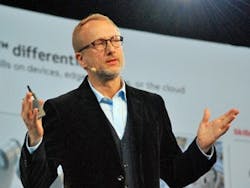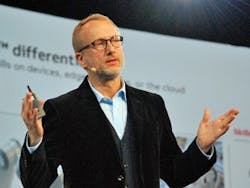“The key is going from automation to autonomy.” ABB’s Guido Jouret outlined the company’s vision for ABB Ability as digital enabler of next-generation systems that will leverage technologies such as artificial intelligence to create adaptive systems that can operate without routine human intervention.
At the last ABB Customer World event—way back in 2017—ABB Chief Digital Officer Guido Jouret announced the launch of ABB Ability, a solution architecture and platform that combines hardware and software elements with enhanced connectivity. The success of that launch is evident to any ABB Customer World 2019 attendees who strolled the exhibit floor, where some 100 solutions employing ABB Ability are on display, from gas-detecting drone devices to submergeable well scanners to robotics performing tasks at blurring speed.
Since that 2017 launch, ABB has enjoyed a 60% increase in digital engagements aligned with 185% more digital customers. Use cases with artificial intelligence and augmented/virtual-reality solutions have blossomed. Cybersecurity has been enhanced at every level. Customers are enjoying enhanced flexibility, greater interoperability among their systems, boosted intelligence and extensibility with access to additional tools.
Overseeing these efforts like a proud poppa is Jouret, who works with teams cutting across all industry sectors. In fact, one of his stated missions is removing silos within the company, enabling ABB Ability projects to scale not only within their original verticals but also across the portfolio—from electrification to industrial automation, motion to robotics and discrete automation. “Digital helps us create and deliver more value to you,” he explained to a room packed full of ABB customers from a diverse range of fields. Heads nodded with approval.
The ABB Ability platform “scales like nobody’s business,” he said, eliciting chuckles. Once applied to, say, a powertrain, it can then be rolled out to tens of thousands of similar pieces of hardware, all sending data to the cloud, enabling it to be accessed by any authorized individual with a phone in his or her hand.
Jouret admitted that the 2017 launch of ABB Ability lacked a key enabling component—the digital twin. He proudly informed the audience that they have addressed that issue, partnering with Dassault Systèmes to develop digital twins that learn, and acquire domain expertise via artificial intelligence. “The key is going from automation to autonomy,” Jouret summarized. “The goal is helping you become a leader in digital industry through the help of autonomous operations.”
ABB’s adoption of digital has been enthusiastically received. Jouret described how his team now commonly receives requests for information, rather than RFPs. They are getting invited to discussions earlier in the process by companies exploring inefficiencies in their supply chains or plant processes. “And when we engage earlier we have better conversations with the CEO or the head of the supply chain,” Jouret noted. “The conversation is about the potential to create hundreds of millions of dollars in value.” (While talking dollars, Jouret noted that ABB has invested some $300 million in Customer Innovation Centers around the world that facilitate these conversations about all that can be accomplished.)
ABB has a strong history in operations. That has been apparent throughout this conference. But the new digital approach heralded by ABB Ability enables ABB to interject earlier, deeper into customers’ plant and product lifecycles. And as customers’ needs change, the ABB Ability Marketplace—an online store for applications—enables customers to customize their tools when new skills must be added to systems. Your robot needs voice-activation? Sure…which language?
Keys to differentiation
Jouret repeatedly touched on the system-wide approach essential to and enabled by ABB Ability. He used the analogy of the nervous system that controls functions of muscle and bone. Rather than digitizing components or just certain elements, the mindset is to pull back and apply solutions strategically to the full body, the full industrial operation. The brain sending smart signals to the elements that implement actions.
In systems engineering speak, these “architectural control points” broaden the scope to unlock the full potential of digital. “The brain that coordinates and optimizes the rest of the system. That is key to our strategy. And not just the pieces of hardware but also the brains at the edge,” Jouret said.
New capabilities enabled by ABB Ability are not only timely, according to the speaker, they might also be critical to millions of global citizens. Jouret referenced the exploding global population and the skyrocketing demand for energy, food and clean water. “Creating a whole new way to feed the world, a planet of over 9 billion people in the next couple of decades,” he said. “We have a massive challenge ahead of us and that is why we need to move with speed to embrace digitalization and autonomous operations.”
That speed and agility and scalability comes courtesy of a smart, strategic, whole-system-focused digital approach. “As we shift toward these new ways of working, we need dramatically more people as well as automation to make those shifts happen,” Jouret proclaimed.
“The robots are coming,” he added. “And just in time.”
About the Author
Chris McNamara
Chris McNamara

Leaders relevant to this article:

